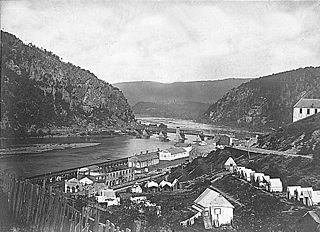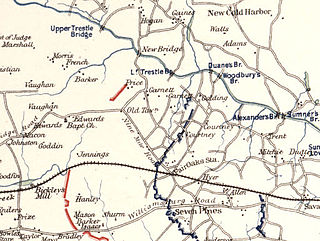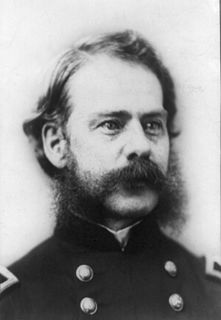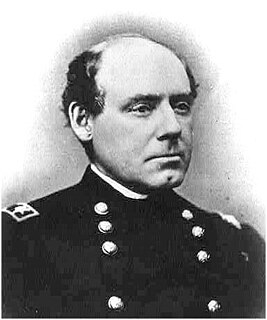Stephen Ward Sears (born July 27, 1932) is an American historian specializing in the American Civil War.
Stephen Ward Sears (born July 27, 1932) is an American historian specializing in the American Civil War.
Sears is a graduate of Oberlin College.
As an author, he has concentrated on the military history of the American Civil War, primarily the battles and leaders of the Army of the Potomac.
He was employed as editor of the Educational Department at the American Heritage Publishing Company. [1]
Sears resides in Connecticut. [2]

The Battle of Antietam, or Battle of Sharpsburg particularly in the Southern United States, was a battle of the American Civil War fought on September 17, 1862, between Confederate Gen. Robert E. Lee's Army of Northern Virginia and Union Gen. George B. McClellan's Army of the Potomac near Sharpsburg, Maryland and Antietam Creek. Part of the Maryland Campaign, it was the first field army–level engagement in the Eastern Theater of the American Civil War to take place on Union soil. It was the bloodiest day in American history, with a combined tally of 22,717 dead, wounded, or missing.

George Brinton McClellan was an American soldier, Civil War Union general, civil engineer, railroad executive, and politician who served as the 24th Governor of New Jersey. A graduate of West Point, McClellan served with distinction during the Mexican–American War (1846–1848), and later left the Army to serve as an executive and engineer on railroads until the outbreak of the American Civil War (1861–1865). Early in the conflict, McClellan was appointed to the rank of major general and played an important role in raising a well-trained and disciplined army, which would become the Army of the Potomac in the Eastern Theater; he served a brief period as Commanding General of the United States Army of the Union Army.

Joseph Hooker was an American Civil War general for the Union, chiefly remembered for his decisive defeat by Confederate General Robert E. Lee at the Battle of Chancellorsville in 1863.

The Army of the Potomac was the principal Union Army in the Eastern Theater of the American Civil War. It was created in July 1861 shortly after the First Battle of Bull Run and was disbanded in June 1865 following the surrender of the Confederate Army of Northern Virginia in April.

John Fulton Reynolds was a career United States Army officer and a general in the American Civil War. One of the Union Army's most respected senior commanders, he played a key role in committing the Army of the Potomac to the Battle of Gettysburg and was killed at the start of the battle.
Tactical or battlefield intelligence became very vital to both sides in the field during the American Civil War. Units of spies and scouts reported directly to the commanders of armies in the field. They provided details on troop movements and strengths. The distinction between spies and scouts was one that had life or death consequences. If a suspect was seized while in disguise and not in his army's uniform, the sentence was often to be hanged. A spy named Will Talbot, a member of the 35th Battalion, Virginia Cavalry, was left behind in Gettysburg after his battalion had passed through the borough on June 26–27, 1863. He was captured, taken to Emmitsburg, Maryland, and executed on orders of Brig. Gen. John Buford.

The Battle of South Mountain—known in several early Southern accounts as the Battle of Boonsboro Gap—was fought on September 14, 1862, as part of the Maryland campaign of the American Civil War. Three pitched battles were fought for possession of three South Mountain passes: Crampton's, Turner's, and Fox's Gaps. Maj. Gen. George B. McClellan, commanding the Union Army of the Potomac, needed to pass through these gaps in his pursuit of Confederate General Robert E. Lee's precariously divided Army of Northern Virginia. Although the delay bought at South Mountain would allow him to reunite his army and forestall defeat in detail, Lee considered termination of the Maryland Campaign at nightfall.

The Battle of Harpers Ferry was fought September 12–15, 1862, as part of the Maryland Campaign of the American Civil War. As Gen. Robert E. Lee's Confederate army invaded Maryland, a portion of his army under Maj. Gen. Thomas J. "Stonewall" Jackson surrounded, bombarded, and captured the Union garrison at Harpers Ferry, Virginia.

The Battle of Hanover Court House, also known as the Battle of Slash Church, took place on May 27, 1862, in Hanover County, Virginia, as part of the Peninsula Campaign of the American Civil War.

The Battle of Oak Grove, also known as the Battle of French's Field or King's School House, took place on June 25, 1862, in Henrico County, Virginia, the first of the Seven Days Battles of the American Civil War. Maj. Gen. George B. McClellan advanced his lines with the objective of bringing Richmond within range of his siege guns. Two Union divisions of the III Corps attacked across the headwaters of White Oak Swamp, but were repulsed by Maj. Gen. Benjamin Huger's Confederate division. McClellan, who was 3 miles (4.8 km) in the rear, initially telegraphed to call off the attack, but ordered another attack over the same ground when he arrived at the front. Darkness halted the fighting. Union troops gained only 600 yards (550 m), at a cost of over a thousand casualties on both sides.
The Battle of Beaver Dam Creek, also known as the Battle of Mechanicsville or Ellerson's Mill, took place on June 26, 1862, in Hanover County, Virginia, as the first major engagement of the Seven Days Battles during the Peninsula Campaign of the American Civil War. It was the start of Confederate General Robert E. Lee's counter-offensive against the Union Army of the Potomac, under Maj. Gen. George B. McClellan, which threatened the Confederate capital of Richmond. Lee attempted to turn the Union right flank, north of the Chickahominy River, with troops under Maj. Gen. Thomas J. "Stonewall" Jackson, but Jackson failed to arrive on time. Instead, Maj. Gen. A.P. Hill threw his division, reinforced by one of Maj. Gen. D.H. Hill's brigades, into a series of futile assaults against Brig. Gen. Fitz John Porter's V Corps, which occupied defensive works behind Beaver Dam Creek. Confederate attacks were driven back with heavy casualties. Porter withdrew his corps safely to Gaines Mill.

The Battle of Savage's Station took place on June 29, 1862, in Henrico County, Virginia, as the fourth of the Seven Days Battles of the American Civil War. The main body of the Union Army of the Potomac began a general withdrawal toward the James River. Confederate Brig. Gen. John B. Magruder pursued along the railroad and the Williamsburg Road and struck Maj. Gen. Edwin Vose Sumner's II Corps with three brigades near Savage's Station, while Maj. Gen. Thomas J. "Stonewall" Jackson's divisions were stalled north of the Chickahominy River. Union forces continued to withdraw across White Oak Swamp, abandoning supplies and more than 2,500 wounded soldiers in a field hospital.

The Battle of Glendale, also known as the Battle of Frayser's Farm, Frazier's Farm, Nelson's Farm, Charles City Crossroads, New Market Road, or Riddell's Shop, took place on June 30, 1862, in Henrico County, Virginia, on the sixth day of the Seven Days Battles of the American Civil War.

The Maryland campaign occurred September 4–20, 1862, during the American Civil War. Confederate Gen. Robert E. Lee's first invasion of the North was repulsed by the Army of the Potomac under Maj. Gen. George B. McClellan, who moved to intercept Lee and his Army of Northern Virginia and eventually attacked it near Sharpsburg, Maryland. The resulting Battle of Antietam was the bloodiest single-day battle in American history.

Theodore Ayrault Dodge was an American officer, military historian, and businessman. He fought as a Union officer in the American Civil War; as a writer, he was devoted to both the Civil War and the great generals of ancient and European history.

The Eastern Theater of the American Civil War consisted of the major military and naval operations in the states of Virginia, West Virginia, Maryland, and Pennsylvania, the District of Columbia, and the coastal fortifications and seaports of North Carolina.

William Hays was a career officer in the United States Army, serving as a Union Army general during the American Civil War.

James Allen Hardie was an American soldier, serving in a number of important administrative positions in the Union Army during the American Civil War.

Seth Williams was an American military officer who served as assistant adjutant general of the Union's Army of the Potomac during the American Civil War.
The Battle of Garnett's and Golding's Farms took place June 27–28, 1862, in Henrico County, Virginia, as part of the Seven Days Battles of the American Civil War's Peninsula Campaign. While the battle at Gaines's Mill raged north of the Chickahominy River, the forces of Confederate general John B. Magruder conducted a reconnaissance in force that developed into a minor attack against the Union line south of the river at Garnett's Farm. The Confederates attacked again near Golding's Farm on the morning of June 28 but in both cases were easily repulsed. The action at the Garnett and Golding farms accomplished little beyond convincing McClellan that he was being attacked from both sides of the Chickahominy.